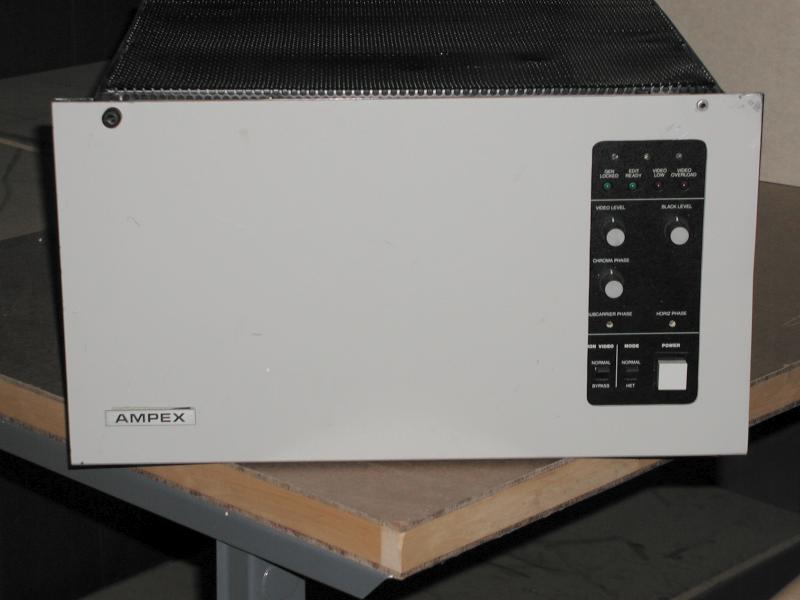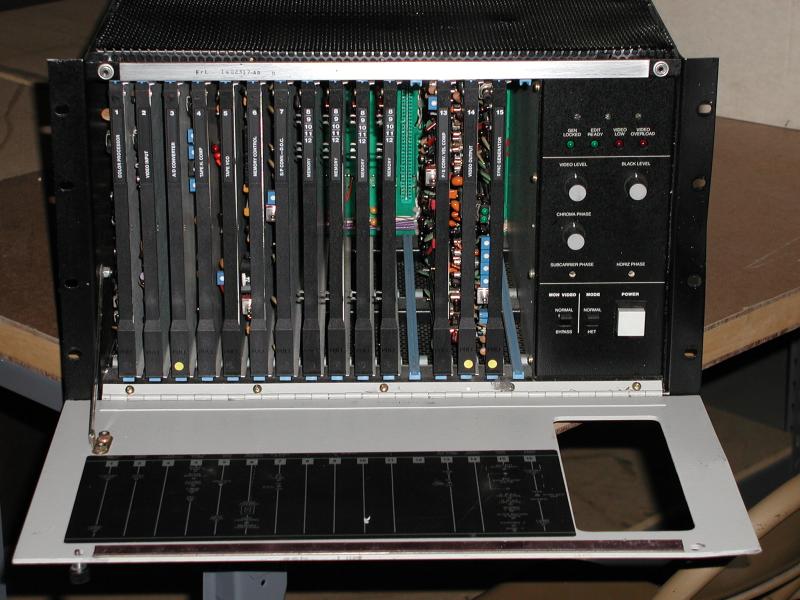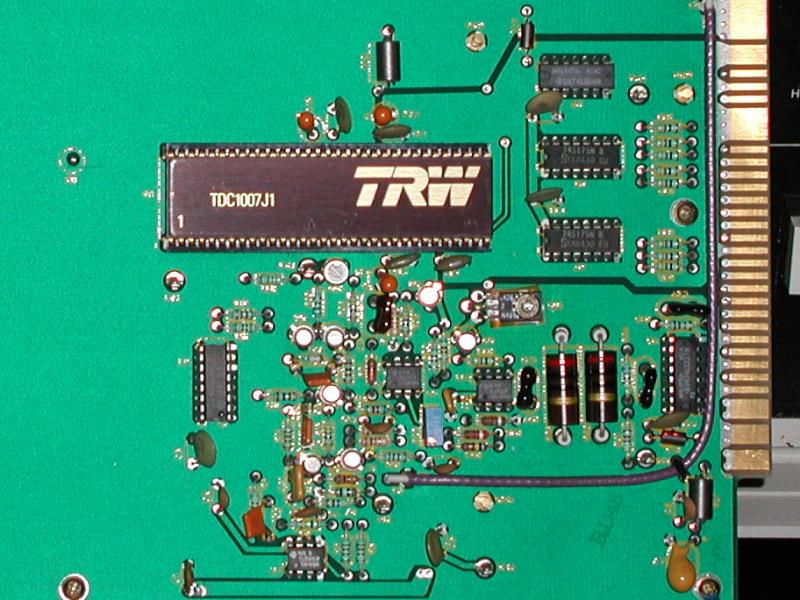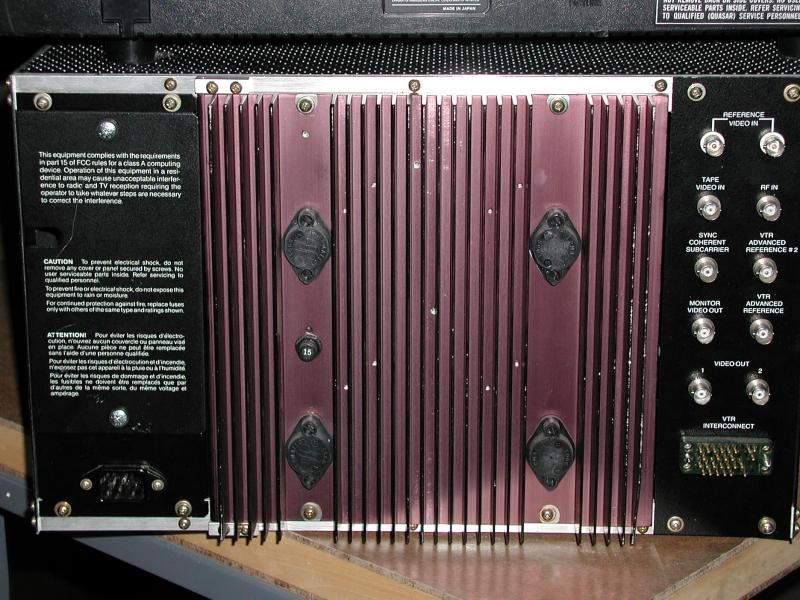LabGuy, what exactly is a Time Base Corrector? I'm glad you asked!
A time
base corrector is a device that removes time variations from a video signal
that is being reproduced from a video tape recorder. This discussion will
focus on direct color video recorders, not be confused with heterodyne
or color under machines like Umatic or VHS. That is a different
discussion. Color under decks separate the color signal from the luma signal
and record them separately to the tape. In a direct color VTR, the entire
video signal modulates an FM carrier signal (like radio) which is recorded
directly to the tape.
Think of
WOW
and FLUTTER in an audio tape recorder. This is a time distortion that
is introduced by speed variations as the tape passes through the transport.
There are many causes, all of them mechanical. A video tape recorder has
all of these time distortions and more. There is the same longitudinal
wow and flutter as in an audio recorder plus the mechanical vibrations
and speed variations of the rotary video head system. Tape stretch and
wrinkles also contribute to time base errors. The result of this is that
the reproduced video signal is constantly changing frequency and phase
during playback. Time base error can, and usually does, contain timing
variations at several different and unrelated frequencies. Each with its
own causal factor.
If the
video tape recorder is referenced to an external sync generator, and the
played back video is compared against that reference, not so subtle time
shifts can be easily observed. On the video monitor, the picture may wobble
back and forth, the top of the picture may bend back and forth dramatically
(called flag waving) and just forget color playback at all! The variations
are hundreds, if not thousands of times greater than what the color demodulators
in the monitor can ever handle. When the VTR is referenced to a stable
signal, like station black reference, the time base averages out to zero
over a long period of time as the VTR minutely slows down and speeds up
to stay in time with the reference. However, at any given instant, the
time error can be many dozens of microseconds off depending on the mechanical
stability of the tape transport.
One solution
to the problem was developed initially for the Quadruplex format VTRs in
the early 1960s. An analog system, called AMTEC (AMpex Timing Error Compensator),
was developed. AMTEC consisted of a lumped delay line of series inductors
and parallel capacitors in the form of varactor diodes. A varactor diode
is a special device that, when reversed biased, behaves like a capacitor.
Better yet, its capacitance can be varied quite a bit by varying the applied
voltage. The time it takes a signal to pass through the delay line can
be varied and controlled very precisely by the applied control voltage.
By passing the playback signal through this delay line, and simultaneously
varying the control voltage in the opposite direction to the video's time
base error, a time restored signal is reproduced. It was possible now to
correct gross errors from the plus and minus ten microsecond range down
to less than plus or minus a quarter or even a tenth of a microsecond!
This mechanism worked well enough to allow the B/W VTRs to be mixed in
with live video for the first time. It was still not good enough for color.
A second
variable delay, with finer control, was inserted in the video path following
the AMTEC which finally brought the video signal back to its original tight
spec of less than plus or minus 2.5 nanoseconds. That is a total error
range of less than five billionths of a second stable! Quite an
accomplishment for the time period. This device was known as COLORTEC.
RCA developed similar solutions with their own unique, and trademarked,
acronyms.
Now AMTEC and COLORTEC
only worked well because the playback from a quadruplex VTR is already
stable to within a couple of microseconds or two millionths of a second.
This type of system was not good |
enough for use with helical
scan VTRs where the time base error averaged between 10 and 150 microseconds
or more. The variable delay lines required would be so long, they would
require their own six foot equipment rack! Not to mention there would be
no signal left by the end of it either. The solution was to go digital!
Convert the playback video into ones and zeroes and store them in computer
memory chips. Applying digital methods to video made it possible to create
any amount of delay desired! (Or that could be afforded!)
The Digital
Time Base Corrector was invented by my good personal friend, Bill Hendershot,
back in about 1972 at his original company, Consolidated Video Systems
(CVS, Inc.) and for which he won an Emmy award. Bill's second company was
called ADDA, which stands for Analog to Digital / Digital to Analog. At
that time, digital memory was so expensive, a digital TBC with only one
or two (video) lines of memory was normal. It would be many years later
when memories became dense enough (and cheap enough) to store a field or
even a frame of video thus creating a new product called a frame synchronizer.
(More about those later...)
On to the
Ampex TBC-1 shown in the photos above. This is the mate to the Ampex VPR-1
one inch type A, and later type C, VTR. [See my
VPR-1 here]. This is an all digital TBC with 12 lines of memory. That
is way more than enough for a VTR as stable as the VPR-1. The 12 line period
is called the
Correction Window. The TBC sends a signal called advanced
sync to the VTR in order to center it's timing in the middle of the
correction window. The VTR returns both off tape video and off tape RF
(radio frequency) to the TBC. The RF is used to sense drop outs, caused
by tape defects and momentary loss of head contact, and triggers the TBC
to repeat the previous line of good video which fills in the gap. Thus
eliminating sparkles in the playback video.
Before
the off tape video signal can be stored in the digital memories, it must
be converted from its normal analog form to a digital form. This is accomplished
by a chip called an Analog to Digital converter or A/D for short. The A/D
chip used in this TBC is shown in the third photo. It is the TRW TDC-1007J.
This is the first single chip converter to be introduced in the mid 1970s.
It is quite likely that this is a very late revision of this board. Earlier
versions of this converter board would have been packed solid with devices
and many complex and critical adjustments! A/D and D/A converter chips
evolved very rapidly at this point in history. We take them for granted
today, but the TDC-1007J was magic in its time! This chip samples
the video at over 14.3 million times per second, generating one byte for
each sample. These bytes are written into the memory chips.
Going from
left to right, in the second photo, the boards contain the input timing
generator which locks to the jittering VTR video, the output timing generator
which locks to the station video reference, the A/D converter, three or
more digital memory boards, and finally a D/A (digital to analog converter)
to give us back the analog form of the video signal.
This black
box made the helical scan video recorder go from a sneered at piece of
junk to the workhorses of the industry! Prior to the introduction of the
digital
time base corrector, only quadruplex VTRs were used for serious video production!
This TBC
can be used with either one inch Direct Color VTRs or with the more common
Heterodyne Color VTRS, like Umatics, Betas, and VHS as long as the VTR
will accept external sync reference. The TBC sends advanced sync to the
VTR in order to center its playback in the middle of the timing window.
In the case of heterodyne or "color under" VTRs, the TBC must first
un-process the color, then add it back to the luma prior to performing
"proper" time base correction.
WANTED:
Nothing! I have all manuals for this device. |







